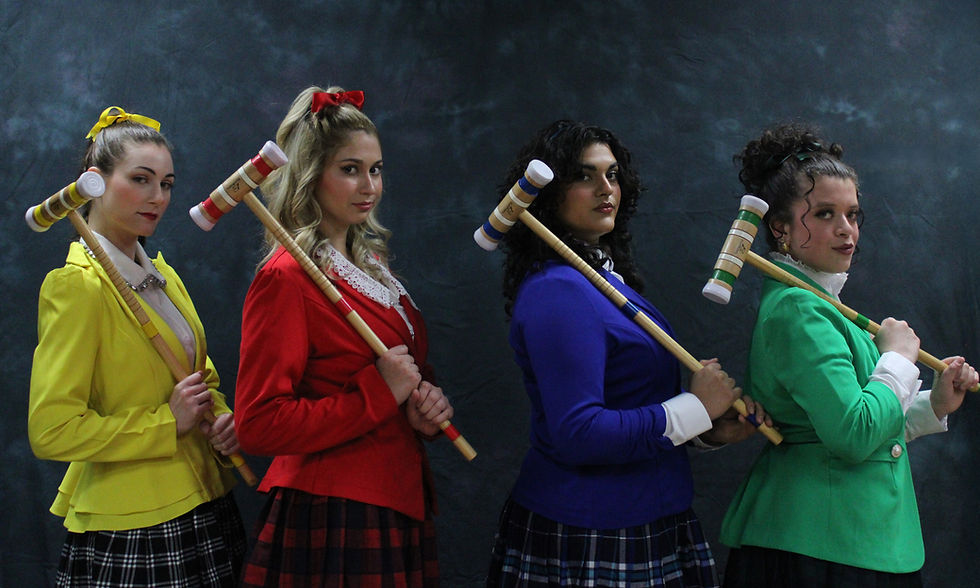'Collective Rage' Comes to The Wayward Artist
- OC Theatre Guild
- Jul 13, 2022
- 3 min read
(The play, not a group of frightening, enraged people)

By Dana Hammer
When I was in high school, I took Drama. Not because I wanted to be a serious actress, but because a lot of my friends were doing it and it seemed like it might be fun. And I was right — it was fun. I especially remember playing the role of Lady Jane Gray. The play itself was unmemorable, and not fantastic, but I LOVED playing that role. (For those of you who might not know, Lady Jane Gray was Queen of England for nine days in the sixteenth century, and was then beheaded.)
When you’re a teenaged girl in a small rural community, your life, shall we say — lacks elegance. Teenaged girls are rarely taken seriously, or treated as if their opinions and feelings are important, especially when they are poor. I was no exception to this, and I felt the slights as much as any girl does. But not when I was playing Lady Jane Gray. As the unfortunate queen, I wore a rich, velvet dress, stood on a stage, and spoke with a strong, cultured voice. My grammar was perfect. I learned to do a proper curtsy for the role, and how to stand up straight and walk with grace. In short, I was able to explore a side of myself that — until then — had never been explored. And I was a better person for it.

Jen Silverman’s darkly comic, queer-centric play, Collective Rage: A Play in Five Betties is (partly) about how theater can help us to explore hidden sides of ourselves, and learn about who we truly are, or can be. It’s about five women who are all named Betty, and who grow and change with each other’s support — and with the help of a restaging of A Midsummer Night’s Dream (retitled “Summer’s Midnight Dream).
Betty 1 is an uptight socialite who throws dinner parties and wears pearls. She has a lot of repressed rage.
Betty 2 is a sexually repressed woman who is secretly addicted to porn.
Betty 3 is a charismatic know-it-all who works at Sephora, until she doesn’t.
Betty 4 is butch, tattooed, gentle, sad, and often ignored.
Betty 5 is fresh out of prison and owns a boxing gym.
We watch as these women grow and change. Betty 1 starts taking kickboxing lessons, getting in touch with her anger. Betty 3 quits her job at Sephora, and devotes her life to the theater. Betty 2 explores her genitalia with a mirror — something she’s never been able to do before. Together, they embark on a journey to produce Summer’s Midnight Dream.
Collective Rage will be presented by The Wayward Artist, directed by Brooke Aston. She’s eager to bring this play to life. When asked what drew her to this play, she says, “I was looking for plays about women and their experience. With the culture wars dominating the news, I read that opening monologue about watching the news and I just knew I had to do this play.”
When asked what she wants the audience to take away from this production, she says, “I want the audience to feel that we've reflected some reality back to them about acceptance of others and of themselves.”
Feminist, queer-centered plays are still uncommonly produced in your average theater, even in 2022, six years after Collective Rage premiered. But things are changing. As we move toward a more inclusive, accepting society, plays like this will give performers and audiences alike an opportunity to explore and learn about themselves in ways that perhaps weren’t acceptable in years past — and to laugh while doing it.

Dana Hammer is a writer and local theater enthusiast living and working in Orange County.
‘Collective Rage’
Location: Grand Central Art Center, 125 N. Broadway, Santa Ana
Run Dates/Times: July 15-31. Fridays and Saturdays 7:30 p.m., Sundays 2 p.m.
$25 general, $15 student
657-205-6273, thewaywardartist.org
This play contains strong language and themes and is recommended for mature audiences.
Note: The full title of this play is Collective Rage: A Play In 5 Betties: In Essence A Queer And Occasionally Hazardous Exploration: Do You Remember When You Were In Middle School And You Read About Shackleton And How He Explored The Antarctic?; Imagine The Antarctic As A Pussy And It's Sort Of Like That. This is, objectively, the greatest play title ever written, and you should see it for that reason alone.












Comments